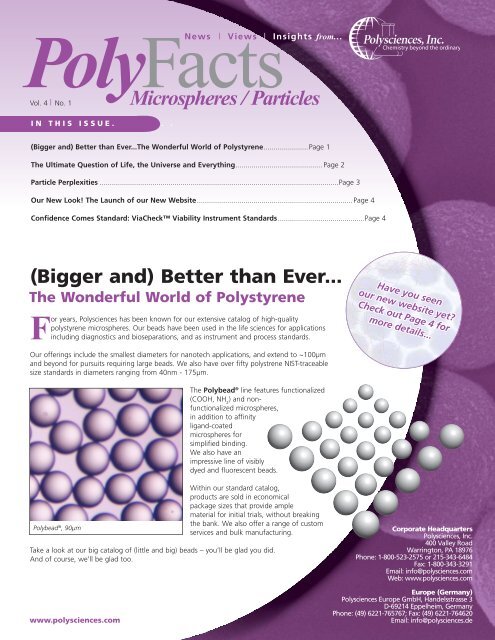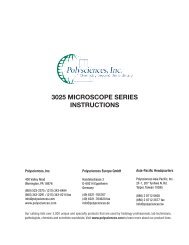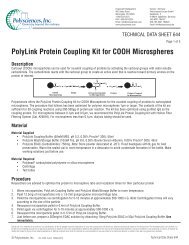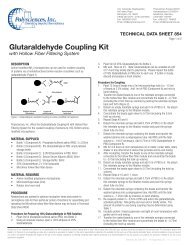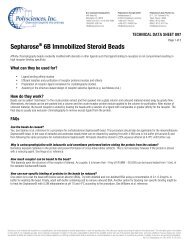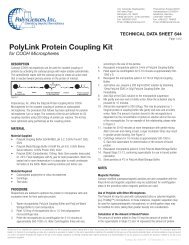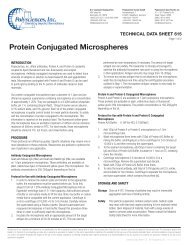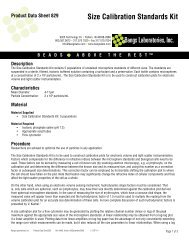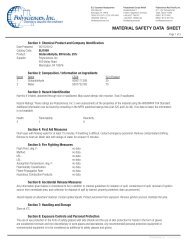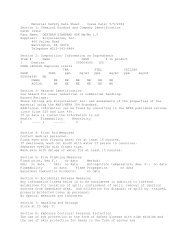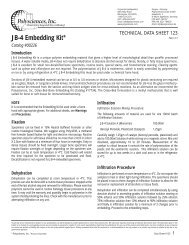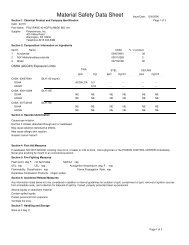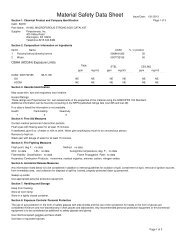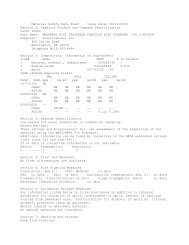PolyFacts - Microspheres/Particles - Polysciences, Inc.
PolyFacts - Microspheres/Particles - Polysciences, Inc.
PolyFacts - Microspheres/Particles - Polysciences, Inc.
Create successful ePaper yourself
Turn your PDF publications into a flip-book with our unique Google optimized e-Paper software.
<strong>PolyFacts</strong><br />
News l Views l Insights from...<br />
Vol. 4 l No. 1<br />
I N T H I S I S S U E . . .<br />
<strong>Microspheres</strong> / <strong>Particles</strong><br />
(Bigger and) Better than Ever...The Wonderful World of Polystyrene......................Page 1<br />
The Ultimate Question of Life, the Universe and Everything........................................... Page 2<br />
Particle Perplexities ......................................................................................................................Page 3<br />
Our New Look! The Launch of our New Website.............................................................................Page 4<br />
Confidence Comes Standard: ViaCheck Viability Instrument Standards...........................................Page 4<br />
(Bigger and) Better than Ever...<br />
The Wonderful World of Polystyrene<br />
For years, <strong>Polysciences</strong> has been known for our extensive catalog of high-quality<br />
polystyrene microspheres. Our beads have been used in the life sciences for applications<br />
including diagnostics and bioseparations, and as instrument and process standards.<br />
Have you seen<br />
our new website yet?<br />
Check out Page 4 for<br />
more details...<br />
Our offerings include the smallest diameters for nanotech applications, and extend to ~100µm<br />
and beyond for pursuits requiring large beads. We also have over fifty polystrene NIST-traceable<br />
size standards in diameters ranging from 40nm - 175µm.<br />
The Polybead ® line features functionalized<br />
(COOH, NH 2<br />
) and nonfunctionalized<br />
microspheres,<br />
in addition to affinity<br />
ligand-coated<br />
microspheres for<br />
simplified binding.<br />
We also have an<br />
impressive line of visibly<br />
dyed and fluorescent beads.<br />
Polybead ® , 90µm<br />
www.polysciences.com<br />
Within our standard catalog,<br />
products are sold in economical<br />
package sizes that provide ample<br />
material for initial trials, without breaking<br />
the bank. We also offer a range of custom<br />
services and bulk manufacturing.<br />
Take a look at our big catalog of (little and big) beads – you’ll be glad you did.<br />
And of course, we’ll be glad too.<br />
Corporate Headquarters<br />
<strong>Polysciences</strong>, <strong>Inc</strong>.<br />
400 Valley Road<br />
Warrington, PA 18976<br />
Phone: 1-800-523-2575 or 215-343-6484<br />
Fax: 1-800-343-3291<br />
Email: info@polysciences.com<br />
Web: www.polysciences.com<br />
Europe (Germany)<br />
<strong>Polysciences</strong> Europe GmbH, Handelsstrasse 3<br />
D-69214 Eppelheim, Germany<br />
Phone: (49) 6221-765767; Fax: (49) 6221-764620<br />
Email: info@polysciences.de
<strong>PolyFacts</strong><br />
<strong>Microspheres</strong> / <strong>Particles</strong><br />
The Ultimate Question of Life, the<br />
Universe and Everything....<br />
or How to Choose a Bead from the Staggering Number of Choices<br />
Choosing the right microsphere for assay development is no small matter. As this<br />
reagent will be responsible for presenting ligand to sample for target capture, it must<br />
possess suitable specific and nonspecific binding characteristics. Once coated, the<br />
active surface will contribute to dynamic range and sensitivity, and its stability will directly<br />
affect shelf life of the finished test. There’s also a good chance that other factors, such as<br />
physical density and optical properties, will be important. But no pressure. Really.<br />
Fortunately, there are many product options that will ensure that basic requirements are met,<br />
and permit tailored performance from there. So many, that test developers can factor matrix,<br />
diameter, surface characteristics and optical properties into bead selection. So many, in fact,<br />
that, short of having unrestricted access to a Magic 8-Ball ® (www.mattel.com), navigating<br />
them can be a bit ticklish.<br />
Figure 1: Polybead ® Carboxylate Dyed<br />
<strong>Microspheres</strong><br />
But never fear – we stand ready to help! Our new Technical Data Sheet #778, Microsphere<br />
Selection, will bring you up to speed, and our Sampler Kits will facilitate the bead<br />
vetting process without turning a blind eye to the budget. We have loads of options<br />
for kits containing polymer beads of different sizes, surface chemistries, visible dyes and<br />
fluorophores. And BioMag ® superparamagnetic particle kits? Don’t even get us started....<br />
So tuck away that 8-Ball, and give us a ring!<br />
Sizes and Surface Chemistries<br />
19822 Polybead ® Sampler Kit I<br />
0.5µm, 0.75µm, 1.0µm, 2.0µm<br />
and 3.0µm<br />
21756 Polybead ® Sampler Kit II<br />
0.1µm, 0.2µm, 0.5µm and 1.0µm<br />
16905 Polybead ® Sampler Kit III<br />
0.05µm, 0.20µm, 0.50µm,<br />
1.00µm, 45.0µm and 90.0µm<br />
19819 Polybead ® Carboxylate Sampler<br />
Kit I<br />
0.5µm, 0.75µm, 1.0µm, 2.0µm<br />
and 3.0µm<br />
21757 Polybead ® Carboxylate Sampler<br />
Kit II<br />
0.1µm, 0.2µm, 0.35µm and 0.5µm<br />
19820 Polybead ® Amino Sampler Kit<br />
0.5µm, 0.75µm, 1.0µm and 3.0µm<br />
24350 PolyLink Protein Coupling Kit for<br />
Carboxylate <strong>Microspheres</strong><br />
19540 Glutaraldehyde Kit for Amino and<br />
Blue Dyed <strong>Microspheres</strong><br />
Colors and Fluorophores<br />
18326 Fluoresbrite ® Carboxylate Color<br />
Range Kit I<br />
1.75µm, 6 different fluorescent<br />
bead populations<br />
19839 Fluoresbrite ® Carboxylate Color<br />
Range Kit II<br />
0.5µm, 6 different fluorescent<br />
bead populations<br />
16906 Polybead ® Dyed Microsphere Kit I<br />
1 undyed and 4 different visibly<br />
dyed bead populations<br />
19821 Polybead ® Blue Dyed Microsphere<br />
Sampler Kit<br />
0.2µm, 0.5µm, 1.0µm and 3.0µm<br />
Did We Mention BioMag ® ?<br />
Seriously – check out our website!<br />
Figure 2: PolyLink Protein Coupling Kit for<br />
Carboxylate Beads<br />
Figure 3: Fluoresbrite ® Carboxylate Fluorescent<br />
<strong>Microspheres</strong><br />
For a complete listing of all your microsphere options, please visit our website at<br />
www.polysciences.com.<br />
Figure 4: BioMag ® Magnetic Immobilization Kit<br />
phone (800) 523-2575 or (215) 343-6484 fax (800) 343-3291 or (215) 343-0214 email info@polysciences.com<br />
2
Particle<br />
Perplexities<br />
Questions & Answers pertaining to <strong>Polysciences</strong>’ <strong>Microspheres</strong> / <strong>Particles</strong><br />
Q: I’m having trouble with bead<br />
stickiness when working with<br />
polystyrene beads in a carbonate<br />
buffer, pH ~9.8. I understand that<br />
SDS is most soluble at high pH (~9-10),<br />
and I’m guessing that the surfactant is<br />
coming off of the bead surface at this pH. I<br />
have thought about using Tween ® 20, but I<br />
have read that ideal pH is 6.5-7.5.<br />
Do you have any thoughts regarding a<br />
surfactant that would be good for pH 9.8?<br />
A: Nonionic surfactants are much<br />
less sensitive to changes in pH than<br />
are anionic surfactants, such as<br />
SDS. We would suggest trying Triton X-<br />
405 or IGEPAL ® CO-890 as alternatives.<br />
Example of well-dispersed 10µm Polybead ®<br />
microspheres.<br />
Q: I want to bind an –NH 2<br />
terminated ligand to carboxylated<br />
polystyrene spheres, and was<br />
wondering what buffer I should<br />
use for coupling. Does it matter?<br />
A: When selecting a coupling<br />
buffer, the main concerns are<br />
generally to keep the biomolecule<br />
happy and to select a suitable pH for the<br />
reaction. The buffer should also be free<br />
of compounds that would interfere or<br />
compete with the reaction or ligand, e.g.<br />
buffers containing free amines, such as Tris.<br />
Borate or carbonate buffers are often used<br />
for coupling, though you should consider<br />
a lower-pH buffer (e.g. MES) when using<br />
a one-step EDAC-based procedure. And,<br />
if you don’t have the time or inclination<br />
for buffer screening, you might consider<br />
using our PolyLink Protein Coupling Kit for<br />
Carboxylate <strong>Particles</strong> (Cat. #24350).<br />
The PolyLink Protein Coupling Kit is<br />
intended for the covalent coupling of<br />
proteins to carboxylated microspheres<br />
and contains a procedure that has been<br />
optimized for polymer microspheres 1µm<br />
or larger. The kit includes EDAC, coupling<br />
buffer, and wash / storage buffer sufficient<br />
for 50 reactions using ~200-500µg<br />
protein and 12.5mg COOH-functionalized<br />
microspheres per reaction.<br />
When working with microspheres 0.1-<br />
0.5µm in diameter, we offer the same<br />
kit reagents as our standard PolyLink Kit<br />
and also include a hollow fiber separation<br />
device to aid in the washing and isolation<br />
steps. For microspheres less than 0.1µm,<br />
we suggest using dialysis tubing or<br />
centrifugal filtration devices.<br />
Cat. No.<br />
Description<br />
24350 PolyLink Protein Coupling<br />
Kit for Carboxylate<br />
<strong>Microspheres</strong><br />
24818 PolyLink Kit with Hollow<br />
Fiber Filtering System<br />
Q: I was hoping you could educate<br />
me a bit on solubility parameters<br />
for polymers. From Leigh<br />
Bangs’ general writings (“Uniform<br />
Latex <strong>Particles</strong>”), I understand that nearmatches<br />
in solubility parameters between<br />
a polymer and solvent indicate that it will<br />
efficiently dissolve the polymer. However,<br />
in looking up solubility parameters on the<br />
Internet, I’ve come across several different<br />
types, e.g. Standard Hildebrand Values, SI<br />
Hildebrand Values, and Hansen Solubility<br />
Parameters. Is there a preferred parameter<br />
and what is the general rule associated<br />
with it?<br />
One more question: is hydrofluoric acid<br />
expected to damage polystyrene with a<br />
low level of crosslinking? Do acids follow<br />
the same rules as organic solvents?<br />
A: The Hildebrand solubility<br />
parameter is usually regarded<br />
as the preferred one. Standard<br />
Hildebrand and SI Hildebrand solubility<br />
parameters are made equivalent through<br />
the use of a conversion factor:<br />
1 (MPa 1/2 ) = 0.48888 (cal 1/2 ) / (cm 3/2 )<br />
We have typically used the standard<br />
solubility parameter values, since much of<br />
the older literature uses standard (English)<br />
units. In this case, the rule of thumb for<br />
solubility of a polymer in a solvent is that<br />
the solubility parameter values are within<br />
1 unit of each other or less. Of course,<br />
chemistry doesn’t always behave as we<br />
expect it to, so this is only a general rule.<br />
The Hildebrand solubility parameter can<br />
be calculated from the 3 Hansen solubility<br />
parameters (i.e., dispersion, polar, and<br />
hydrogen bonding parameters):<br />
d (Hildebrand) = (d d<br />
1/2<br />
+ d p<br />
1/2<br />
+ d h<br />
1/2<br />
) 1/2<br />
Acids don’t always follow the solubility<br />
parameter principle, since they don’t<br />
necessarily dissolve material, they react<br />
chemically with it. (Of course, some acids,<br />
like acetic acid, are also organic solvents,<br />
and would dissolve polymers within their<br />
solubility parameter range.)<br />
The literature indicates that polystyrene<br />
is generally resistant to hydrofluoric acid,<br />
except under harsh conditions (high<br />
concentration, elevated temperature,<br />
etc.). The degree of crosslinking would<br />
not affect the resistance of the polymer to<br />
hydrofluoric acid.<br />
www.polysciences.com<br />
3
<strong>PolyFacts</strong><br />
<strong>Microspheres</strong> / <strong>Particles</strong><br />
Our New Look!<br />
The Launch of our New Website<br />
<strong>Polysciences</strong> is pleased to announce<br />
the launch of our new website. In<br />
order to provide you with an easier<br />
and more secure online experience, we<br />
redesigned our web site and are thrilled<br />
to announce its completion. Of course,<br />
if you’ve visited the website recently, still<br />
located at www.polysciences.com,<br />
you have already noticed the dramatic<br />
difference. For those of you who haven’t<br />
visited us lately, wait until you see what we<br />
have in store for you!<br />
For starters, with an increased search<br />
functionality, as well as a highly structured<br />
navigation system, we’re sure that you’ll<br />
find whatever products or information you<br />
need – quickly and easily.<br />
Not only did we simplify our search<br />
function, but also increased the amount<br />
of information available to you online. Our<br />
catalog, newsletters, Technical Data Sheets,<br />
and Material Safety Data Sheets are all<br />
available in our Technical Information<br />
section. Sound daunting? Never fear.<br />
We’ve simplified that too. Most of the<br />
products you seek will have links from the<br />
product page to the information you need–<br />
immediately available for downloading.<br />
Have a question? Need to contact us?<br />
Don’t be shy! Let us know what you think<br />
about our new website and our products.<br />
Don’t forget – we’re here for you. Ask your<br />
questions too. We are here to help – and<br />
we’re only a simple click away!<br />
Not in the United States? Where do<br />
you find our products? Check out our<br />
Distributor page to find not only your<br />
nearest distributor, but their email and<br />
website information. Just one click takes<br />
you directly to their inbox or website!<br />
So see what the excitement is all about.<br />
Visit our website at www.polysciences.<br />
com today. We hope you like it, too!<br />
Confidence Comes Standard<br />
ViaCheck Viability Instrument Standards<br />
Instrumental methods for cell viability analysis provide significant advantages over manual determinations, offering high accuracy,<br />
precision and throughput. However, as with any analytical instrument, it is important to implement a QC program to ensure confidence<br />
in results.<br />
ViaCheck Viability Instrument Standards can provide just that confidence. ViaCheck Viability products are microsphere-based standards<br />
that mimic the light scattering characteristics of “live” and “dead” cells in the trypan blue exclusion method, and may be used to confirm the<br />
capabilities and verify the performance of image-based cell viability instruments.<br />
For more information about our ViaCheck<br />
products, visit us at www.polysciences.com.<br />
Cat. No.<br />
ViaCheck Description<br />
24622 0% Viability Control<br />
24623 50% Viability Control<br />
24624 75% Viability Control<br />
24625 90% Viability Control<br />
24626 100% Viability Control<br />
Count<br />
200<br />
100<br />
0<br />
Size Distribution<br />
20<br />
Diameter (µm)<br />
40<br />
Count<br />
200<br />
100<br />
0<br />
Viable Cell Size Distribution<br />
20<br />
Diameter (µm)<br />
ViCell XR data and photograph of ViaCheck 50% Viability<br />
Control particles<br />
40<br />
20µm Viable (clear)<br />
10µm Non-Viable (blue)<br />
phone (800) 523-2575 or (215) 343-6484 fax (800) 343-3291 or (215) 343-0214 email info@polysciences.com<br />
4<br />
www.polysciences.com


